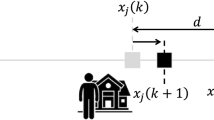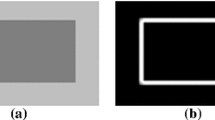Abstract
Unsupervised image segmentation algorithms aim at identifying disjoint homogeneous regions in an image and have been subject to considerable attention in the machine vision community. In this paper, a popular theoretical model with its origins in statistical physics and social dynamics, known as the Deffuant–Weisbuch model, is applied to the image segmentation problem. The Deffuant–Weisbuch model has been found to be useful in modelling the evolution of a closed system of interacting agents characterised by their opinions or beliefs, leading to the formation of clusters of agents who share a similar opinion or belief at steady state. In the context of image segmentation, this paper considers a pixel as an agent and its colour property as its opinion, with opinion updates as per the Deffuant–Weisbuch model. Apart from applying the basic model to image segmentation, this paper incorporates adjacency and neighbourhood information in the model, which factors in the local similarity and smoothness properties of images. Convergence is reached when the number of unique pixel opinions, i.e., the number of colour centres, matches the pre-specified number of clusters. Experiments are performed on a set of images from the Berkeley image segmentation dataset, and the results are analysed both qualitatively and quantitatively, which indicate that this simple and intuitive method is promising for image segmentation. To the best of the knowledge of the author, this is the first work where a theoretical model from statistical physics and social dynamics has been successfully applied to image processing.


Similar content being viewed by others
References
Achanta, R., Shaji, A., Smith, K., Lucchi, A., Fua, P., Süsstrunk, S.: Slic superpixels. Tech. rep., Ecole Polytechnique Federale de Lausanne (EPFL), School of Computer and Communication Sciences (2010)
Achanta, R., Shaji, A., Smith, K., Lucchi, A., Fua, P., Süsstrunk, S.: Slic superpixels compared to state-of-the-art superpixel methods. IEEE Trans. Pattern Anal. Mach. Intell. 34(11), 2274–2282 (2012)
Bowyer, K., Kranenburg, C., Dougherty, S.: Edge detector evaluation using empirical ROC curves. Comput. Vis. Image Underst. 84(1), 77–103 (2001)
Buchanan, M.: The social atom: why the rich get richer, cheats get caught, and your neighbor usually looks like you. Marshall Cavendish, London (2007)
Carletti, T., Fanelli, D., Grolli, S., Guarino, A.: How to make an efficient propaganda. EPL (Europhys. Lett.) 74, 222–228 (2006)
Castellano, C., Fortunato, S., Loreto, V.: Statistical physics of social dynamics. Rev. Mod. Phys. 81, 591–646 (2009)
Chakrabarti, B.K., Chakraborti, A., Chatterjee, A.: Econophysics and Sociophysics. Wiley-VCH Verlag GmbH & Co., Weinheim, Germany (2006)
Clifford, P., Sudbury, A.: A model for spatial conflict. Biometrika 60(3), 581–588 (1973)
Deffuant, G., Neau, D., Amblard, F., Weisbuch, G.: Mixing beliefs among interacting agents. Adv. Complex Syst. 03(01n04), 87–98 (2000)
Flamm, D.: History and outlook of statistical physics. ArXiv Physics e-prints (1998)
Fortunato, S.: Universality of the threshold for complete consensus for the opinion dynamics of deffuant, et al. Int. J. Mod. Phys. C 15(9), 1301–1307 (2004)
Fu, K., Mui, J.: A survey on image segmentation. Pattern Recognit. 13(1), 3–16 (1981)
Häggström, O., Hirscher, T.: Further results on consensus formation in the Deffuant model. Electron. J. Probab. 19(19), 1–26 (2014)
Hegselmann, R., Krause, U.: Opinion dynamics and bounded confidence, models, analysis and simulation. J. Artif. Soc. Soc. Simul. 5(3) (2002)
Hirscher, T.: Consensus formation in the Deffuant model. Department of Mathematical Sciences, Chalmers University of Technology, (2014)
Jain, A.K.: Data clustering: 50 years beyond k-means. Pattern Recognit. Lett. 31(8), 651–666 (2010)
Liggett, T.M.: Interacting Particle Systems. Springer, Berlin (1985)
Martin, D., Fowlkes, C., Tal, D., Malik, J.: A database of human segmented natural images and its application to evaluating segmentation algorithms and measuring ecological statistics. In: Proceeding 8th International Conference on Computer Vision, vol. 2, pp. 416–423 (2001)
Pal, N.R., Pal, S.K.: A review on image segmentation techniques. Pattern Recognit. 26(9), 1277–1294 (1993)
Shang, Y.: Deffuant model with general opinion distributions: first impression and critical confidence bound. Complexity 19(2), 38–49 (2013)
Shang, Y., Bouffanais, R.: Influence of the number of topologically interacting neighbors on swarm dynamics. Sci. Rep. 4, 4184 (2014). doi:10.1038/srep04184
Stanley, H.: Exotic statistical physics: applications to biology, medicine, and economics. Phys. A Stat. Mech. Appl. 285(1), 1–17 (2000)
Sznajd-Weron, K., Sznajd, J.: Opinion evolution in closed community. Int. J. Mod. Phys. C 11, 1157–1165 (2000)
Tomasi, C., Manduchi, R.: Bilateral filtering for gray and color images. In: Proceedings of the Sixth International Conference on Computer Vision, pp. 839–846. IEEE Computer Society (1998)
Weidlich, W.: The statistical description of polarization phenomena in society. Br. J. Math. Stat. Psychol. 24(2), 251–266 (1971)
Wu, X., Kumar, V., Ross Quinlan, J., Ghosh, J., Yang, Q., Motoda, H., McLachlan, G.J., Ng, A., Liu, B., Yu, P.S., Zhou, Z.H., Steinbach, M., Hand, D.J., Steinberg, D.: Top 10 algorithms in data mining. Knowl. Inf. Syst. 14(1), 1–37 (2007)
Author information
Authors and Affiliations
Corresponding author
Rights and permissions
About this article
Cite this article
Kayal, S. Unsupervised image segmentation using the Deffuant–Weisbuch model from social dynamics. SIViP 11, 1405–1410 (2017). https://doi.org/10.1007/s11760-017-1100-0
Received:
Revised:
Accepted:
Published:
Issue Date:
DOI: https://doi.org/10.1007/s11760-017-1100-0




